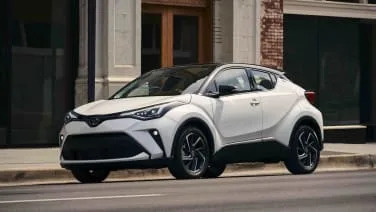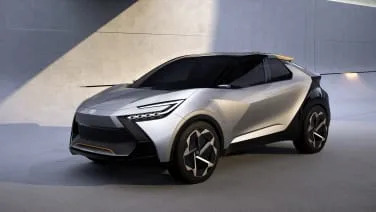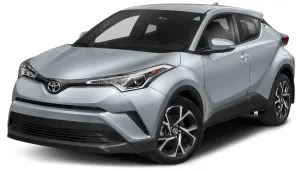XLE Premium 4dr Front-Wheel Drive Sport Utility
2018 Toyota C-HR
A totally new vehicle, the 2018 Toyota C-HR stands apart from other small crossover utilities with trendy looks and a high-riding stance. C-HR stands for Coupe, High Riding. Conceived for Toyota's youth-oriented Scion brand, which disappeared during 2016, it looks smaller than its dimensions suggest. Indisputably, the C-HR is one of the most audacious new models in recent memory, especially startling because it comes from a manufacturer long known for conservative products.
Although all-wheel drive is unavailable, Toyota calls the C-HR a crossover. We see it more as a small five-door hatchback that's taller than most. That translates to a higher seating position.
Visually intricate yet enticing, the C-HR's exterior is its most notable feature by far. Inside, the C-HR looks interesting enough, but mainly functional. Performance, in contrast, is sluggish.
Only two trim levels are offered: XLE and XLE Premium.
In each C-HR, a 2.0-liter four-cylinder engine makes 144 horsepower and 139 pound-feet of torque, coupled to a continuously variable transmission (CVT). Front-wheel drive is the sole configuration.
Three drive modes are available: normal, fuel-efficient Eco, and Sport. The latter re-programs the CVT to provide seven simulated gear ratios. Steering gets a tad firmer, too.
Manufactured in Turkey, the C-HR competes against the joyful Mazda CX-3, fuel-efficient Honda HR-V, and comparably conspicuous Nissan Juke. All-wheel drive is available on those models.
Ten airbags and a rearview camera are standard along with the Toyota Safety Sense-P group of active-safety features. They include forward-collision warning with automatic emergency braking and pedestrian detection, lane-departure alert with steering assist, adaptive cruise control, and automatic high beams.
A lockout for the touchscreen blocks functions that cannot be used unless the vehicle is stationary. Blind-spot monitoring and rear cross-traffic alert are standard with XLE Premium trim.
Visibility to the rear side is constricted. Back-seat headrests don't block much of the view through the sharply-angled rear window, but it's limited nonetheless. Thick pillars don't help.
Full Review
Full Review
C-HR stands for Coupe, High Riding. Conceived for Toyota's youth-oriented Scion brand, which disappeared during 2016, it looks smaller than its dimensions suggest. Indisputably, the C-HR is one of the most audacious new models in recent memory, especially startling because it comes from a manufacturer long known for conservative products.
Although all-wheel drive is unavailable, Toyota calls the C-HR a crossover. We see it more as a small five-door hatchback that's taller than most. That translates to a higher seating position.
Visually intricate yet enticing, the C-HR's exterior is its most notable feature by far. Inside, the C-HR looks interesting enough, but mainly functional. Performance, in contrast, is sluggish.
Only two trim levels are offered: XLE and XLE Premium.
In each C-HR, a 2.0-liter four-cylinder engine makes 144 horsepower and 139 pound-feet of torque, coupled to a continuously variable transmission (CVT). Front-wheel drive is the sole configuration.
Three drive modes are available: normal, fuel-efficient Eco, and Sport. The latter re-programs the CVT to provide seven simulated gear ratios. Steering gets a tad firmer, too.
Manufactured in Turkey, the C-HR competes against the joyful Mazda CX-3, fuel-efficient Honda HR-V, and comparably conspicuous Nissan Juke. All-wheel drive is available on those models.
Ten airbags and a rearview camera are standard along with the Toyota Safety Sense-P group of active-safety features. They include forward-collision warning with automatic emergency braking and pedestrian detection, lane-departure alert with steering assist, adaptive cruise control, and automatic high beams.
A lockout for the touchscreen blocks functions that cannot be used unless the vehicle is stationary. Blind-spot monitoring and rear cross-traffic alert are standard with XLE Premium trim.
Visibility to the rear side is constricted. Back-seat headrests don't block much of the view through the sharply-angled rear window, but it's limited nonetheless. Thick pillars don't help.
Hide Full Review
Retail Price
| Engine | 2.0L I-4 |
| MPG | 27 City / 31 Hwy |
| Seating | 5 Passengers |
| Transmission | 2-spd CVT w/OD |
| Power | 144 @ 6100 rpm |
| Drivetrain | front-wheel |





